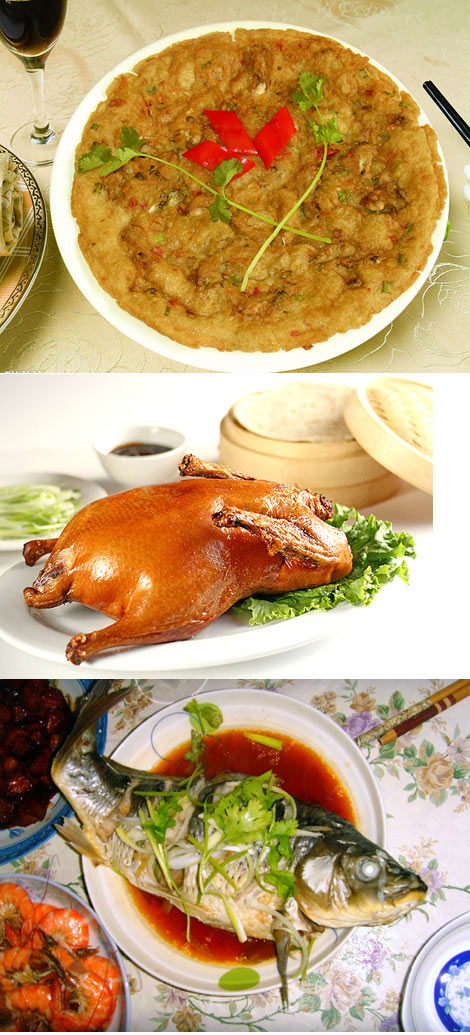Delicacies
Top tastes
Updated: 2011-07-31 08:30
(China Daily)
 |
11. Stewed lamb with unleavened bread羊肉泡馍
This dish is common all over the northwest of China but enjoys the best reputation in Xi'an, the ancient capital. A bubbling cauldron of stewed lamb is placed on the table with a basket of unleavened bread much like the Middle-eastern pita. In both its ingredients and form, it is clear where the original influences had come from, Xi'an being one of the major stops on the Silk Route. But the flavors are now uniquely Shaanxi. The stew of lamb, or beef, is strongly flavored, with the addition of star anise, cumin, cinnamon, ginger, scallions and the ubiquitous Sichuan peppers. The baked bread is then broken up in crumbs the size of beans and dropped into the gravy to let them soak up all the flavors. Xi'an gourmets will happily educate the uninitiated on the whole process. It is an indication of the dish's unbeatable popularity to see it in major restaurants all over the country these days.
12. Braised Beef Shin Beer food酱牛肉
Or rather, food that will go with the fiery white liquor that Beijing burghers are so fond of. No gathering of the feisty Beijing male for a feast of food and spirits will be complete without a platter of thickly sliced braised beef shin, together with the red-skinned peanuts, braised duck necks and stewed chicken feet. It will be a messy table-top before the end of the night, but this is food that will go with the little cups of erguotou, that white spirit of 56 proof that will sear its way down the gullet. The shin must have veins of tender tendons running through, laced in intricate patterns. The beef itself is slowly simmered in a stock of soy sauce and star anise until it is chopstick tender, then cooled and sliced.
13. Dongpo Pork东坡肉
Credited and named after Song Dynasty poet and failed court official Su Dongpo, this dish of braised pork belly is as much loved for its association with the great man as for its own richness. It is also one of China's most "hijacked" dishes, having been claimed by French, Australian and American chefs as part of their signature repertoire. The flattery is accepted as tribute, but first let's go back to the romantic origins, with just that touch of pathos. Su Dongpo, too outspoken and with no mastery of flattery, was often exiled from the Song court. When he was sent to Hangzhou, a remote corner of the empire, he had to make do with a miserly stipend. Being the gourmet he was, he soon focused his talent on making poor ingredients taste delicious. Dongpo pork is one such – a cheap belly cut with its fat rendered through slow, patient simmering in wine and seasoning until it becomes fit for an emperor, or in this case, the emperor's official.
14. Jingjiang rousi京酱肉丝
Our newsroom poll voted this dish on par with the Capital's famous duck. And no wonder, because it was created by a poor tofu-maker who could not afford the Peking duck his only grandson had longed to taste. The touching story behind jingjiang rousi, or pork strips in Peking duck sauce, also highlighted the elitism behind the duck dish, which was mainly served in banquet halls for the exclusive rich in the old days. Old Chen the tofu-maker made tofu in the poorer hutongs and lived with his only grandson. He could not afford to buy a duck so he chose some lean meat and cut them into strips which he stir-fried in the sweet bean sauce used for the duck. He could not afford the pancake wrappers either, so he used his beancurd skins to wrap the meat strips. The squares of bean curd skin are still used today.
15. Whole Lamb on the spit烤全羊
A legacy from China's nomadic rulers, this hearty repast was first introduced during the Yuan dynasty when the Mongols captured the country. They refined the roasting of whole lamb on the spit, as befitting the rulers of a land rich in culinary heritage. By the time another nomadic tribe, the Manchus, again ruled Beijing, the eating of the whole lamb had become a ritual, with garnishes and side dishes never seen on the steppes. The concept may have originated in the northern pastures, but the serving and eating of the whole roast lamb have now been seasoned by other migrant influences, including the strong spices from Xinjiang, especially cumin.
16. Nanjing Salt-water Duck南京盐水鸭
It all starts with a master stock that is preserved in a pot passed down through generations, boiled and re-boiled until it captures the essence of a thousand ducks. This is the ambrosia that makes the Nanjing Saltwater Duck so rightly famous. The chefs who first cooked the duck were masters of flavor, scent and texture. Through a series of processes that involved macerating, blanching, cooling and then soaking, they created a bird that offers taut skin, a thin layer of creamy fat, meat that is tender and redolent with the lingering musk of Sichuan peppercorns, licorice, star anise and cinnamon, evoking the fragrance of osmanthus flowers. This explains why the dish is also known as guihua yazi, or Osmanthus Duck. Much time, patience and culinary devotion goes into the cooking and the result is a duck that would tempt the gods. It was certainly one fit for the emperors who demanded ducks as tribute from Nanjing.
17. Beggar's Chicken叫化鸡
Many stories revolve around the dish, but all agree it was a poor beggar that inspired it. It was an unnamed time when the courts imposed heavy taxes on the people. Forced out of their homes by poverty, many were left on the streets. One beggar driven by hunger, stole a landlord's chicken. He had already built a fire to roast the chicken when he heard the landlord's serfs coming after the stolen goods. The beggar quickly decided to hide the bird in a ball of mud, and threw it into the fire. The servants came, saw no chicken and departed. When the fire died and the beggar could finally rake out the mud-covered chicken, he decided to see if it was still edible. To his surprise, he found he had just invented a gourmet dish. These days, the Beggar's Chicken is also known as Fortune Chicken, in an attempt perhaps to distance the dish from its morally questionable origins.
 |
18. Oyster Omelette蚝烙
When visitors visit Xiamen or Shantou, they inevitably head for the many street-side stalls selling oyster omelettes. It is a casual snack that demands the freshest ingredients, and like all delicious regional food, these are all found within kilometers of the cooks. We certainly don't have to worry about food miles here. Oysters found on the shores of these coastal cities are freshly shucked and fried in a batter made from potato starch, another well-known local product. It might as well be called an oyster pancake, but for the addition of duck's eggs seasoned with savory fish sauce. What results is an omelette with a hot crisp batter base, topped by a generous heap of oysters seasoned with a bit of garlic and chili and then garnished with generously handfuls of chopped coriander and scallions.
19. Peking Duck北京烤鸭
This is probably Beijing's most well-known dish and reportedly the most-loved at the Games Village during the 2008 Olympics. It has also garnered the honor of being listed by CNNGo as the world's 5th most delicious food. Specially bred ducks are force-fed and fattened, then killed, cleaned and roasted over fruit-wood. The crisp skin and tender flesh are traditionally eaten with a thin pancake smeared with a sweet bean sauce and garnished with northern green onions and cucumber strips. Some locals like to dip the skin in sugar.
20. Cantonese Steamed Fish清蒸鱼
No one cooks fish like the Cantonese. The freshest fish, preferably still alive minutes before it goes on the steamer, is steamed with nothing more than the classic trio of scallions, ginger and coriander leaves, a herbal mix equivalent to the bouquet garni. The timing of the cooking must be perfect, with the fish flesh just flaking off the bone, but still firm, tender and sweet. Boiling hot groundnut oil seasoned with sesame oil and the best quality soy sauce is then sizzled over the steamed fish, instantly creating a delicious sauce when the mixture meets the juices of the steamed fish. It is an essence highly prized for adding to a bowl of snowy steamed rice – sometimes more valued than the fish itself.
E-paper

Double vision
Prosperous Hangzhou banks on creative energies to bridge traditional and modern sectors
Minding matters
A touch of glass
No longer going by the book
Specials

Carrier set for maiden voyage
China is refitting an obsolete aircraft carrier bought from Ukraine for research and training purposes.

Pulling heart strings
The 5,000-year-old guqin holds a special place for both european and Chinese music lovers

Fit to a tea
Sixth-generation member of tea family brews up new ideas to modernize a time-honored business
